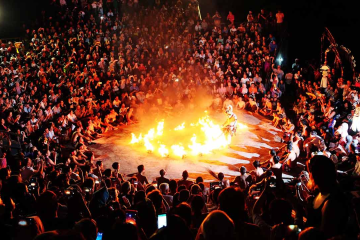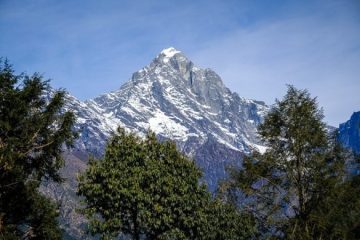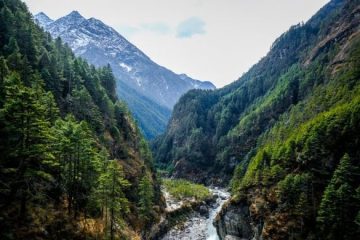Seriously though, with the possible exception of some places in Hawaii, I’ve never been anywhere that looks more like a Jurassic Park movie set.
The nature at Rammang is just wonderful. You can hop in a boat and go down the river seeing giant mountains, caves, prehistoric art, and more.
This travel guide will explain how to get to Rammang Rammang, what to do there, where to stay, and everything else you need to know before you go!
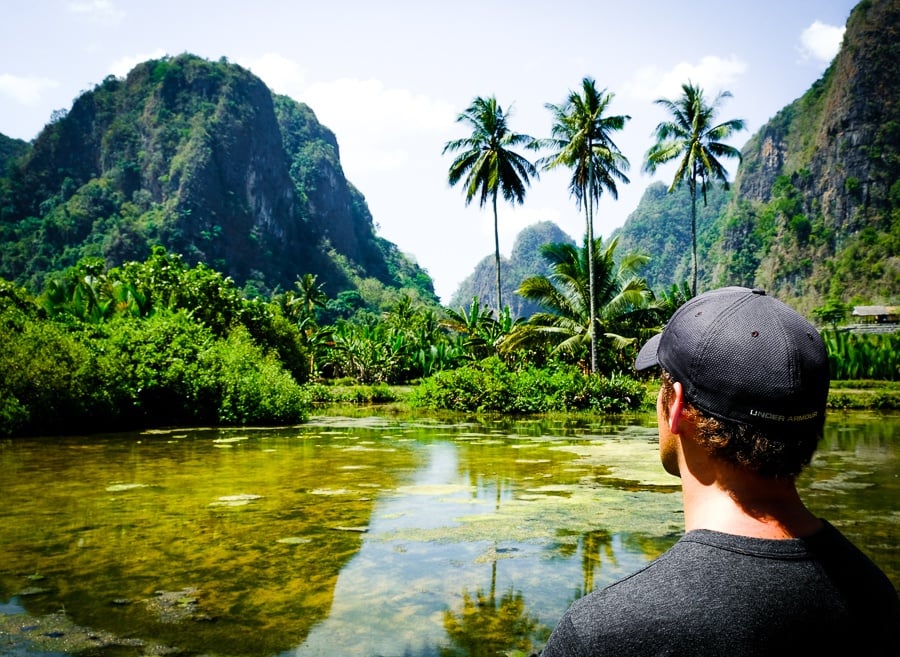



What Is This Place?
The karst mountains at Rammang Rammang were formed by limestone erosion over the ages, and they’ve been settled since prehistoric times. The name means ‘set of clouds or mist’.
This is one of the biggest karst areas in the world, right behind the Tsingy area in Madagascar and Shilin in China. I also think it has a lot of similarities to Krabi in Thailand and Ha Long Bay in Vietnam, although that last one is underwater now.
As of 2024, this place is still mostly unknown to tourists, but it’s easily one of the best places to visit in Indonesia!
Where To Stay
There are some very basic homestays in Rammang Rammang village if you want to stay near the karsts or get an early start for sunrise, which can be nice for photos.
The most popular homestays are Nasrul House and Rammang Rammang Eco Lodge. Food options include Cafe Puncak and Salenrang Cafe, or the Eco Lodge also has a cafe too.
The main advantage of staying in Rammang is just if you want to see the sunrise. We like to stay in Makassar city instead, and I think for most travelers that’s generally your best bet, because Makassar has lots of restaurants and nice hotels in all price ranges.
The Makassar hotels below are some of our top recommendations! You can also see more options here.
Makassar Hotels
How To Get To Rammang Rammang
Rammang village is located in south Sulawesi, Indonesia.
The nearest airport is Sultan Hasanuddin International Airport (UPG) in Makassar, which has direct flights from Bali (DPS) or Kuala Lumpur (KUL).
If you’re coming from Bali, the flight is only 90 minutes and it’s offered by several different airlines. You can shop for flights to Makassar at Skyscanner.
Rammang is a 1 hour drive from the Makassar airport, or a 1.5 hour drive from the city center of Makassar. The two best transport options are with a day driver or a taxi (more info on this below).


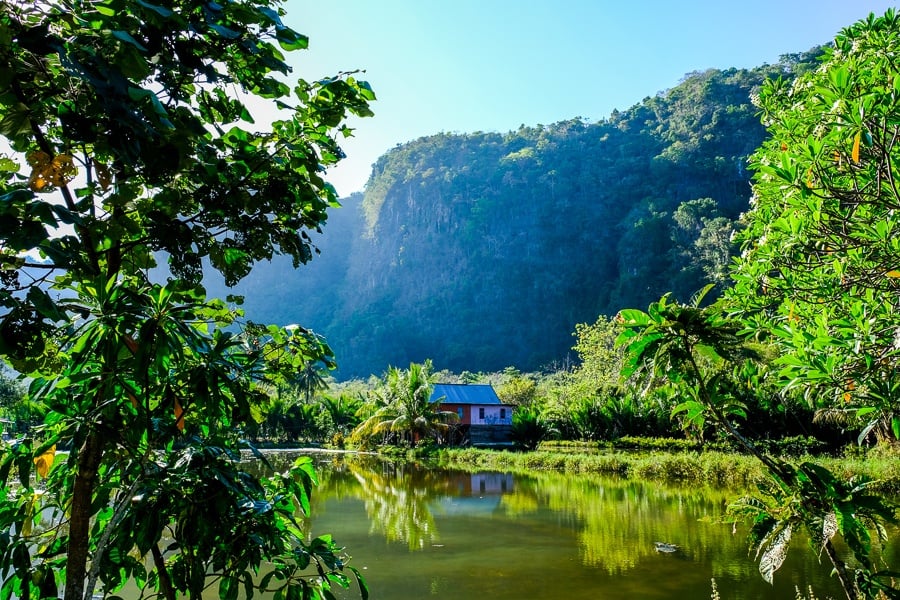
Our Makassar Driver
The easiest way to visit Rammang is to book a driver from Makassar for the day, which should cost about 600k Rupiah ($40 USD) for the whole car and driver (up to 12 hours).
We’ve booked trips with Dodo Mursalim from Makassar and had a great experience. He’s very friendly, helpful, and punctual, and he already knows how to find all of the places you see on this page.
You can contact Dodo on his Facebook page or via WhatsApp at ☎ +62 812-4129-913. He also speaks English.
Other Transport
If you’re on a tight budget, a potentially cheaper way to visit Rammang is to take a Grab or Go-Jek taxi from Makassar.
It costs about 100-150k Rupiah ($7-10 USD) one way. The downside with a taxi is that you’ll need to find a driver for the return trip. There won’t be Grab or Go-Jek drivers in the Maros area, which means you’ll have to get a local taxi from the village.
The return trip with a local taxi from Rammang can cost upwards of 300k ($20) since it’s a remote area and they can determine their own pricing. So you don’t save a whole lot compared to a day driver.
Nasrul, the friendly owner of Nasrul Homestay in Rammang, can arrange a return taxi for you if you need it. His WhatsApp is ☎ +62 823-4700-2175 and he speaks good English.





Entrance Fees
- Berua Village: 10k IDR (~$1)
- Fireflies Cave: 10k IDR
Visiting Rammang Rammang
The best way to explore Rammang is on foot and by traditional boat. There are walking paths that you can use to reach all of the main objects of interest, and the trails are pretty flat.
The paths are well marked with signs pointing you in the right direction, and there’s a good map posted at the main entrance to the area. The only challenge is the midday heat, which can be pretty intense.
You can see most of the highlights in one full day trip, but if you want to see everything on this page you’ll need a couple days.
The list below isn’t a complete list of all the interesting things to see and do at Rammang, but just some of my favorites!

Best Things To Do & See
• Berua Village (Kampung Berua)
This village is the highlight of any trip to Rammang.
There’s a big pond reflecting the mountains and jungle, with 3 perfect palm trees lined up in a row. It’s an epic view that never gets old!
The main way to get to Berua is by boat (see below), but there’s also a secret path to hike there for sunrise if you talk to Nazrul.


• Pute River Boat Trips
Boat trips on the Pute river are one of the most popular ways to explore Rammang.
I skipped this at first because it’s a bit overpriced for only one or two people — 200k Rupiah ($14) return per boat. The river views are pretty nice, though, and it reminded me a bit of Vietnam.
If you have other people to share the boat with, then the price would be worth it. You can fit 6 people per boat, and the ride takes 20 minutes each way.


• Fireflies Cave (Goa Kunang Kunang)
This is a big cave with sparkling limestone formations that look like fireflies blinking at night.
The cave is big enough that you’ll have to climb a couple of ladders to reach the top.
It’s hard to capture the beautiful lights and colors here with a camera, so you’ll have to go see it for yourself!

• Prehistoric Cave (Goa Bulu Barakka)
This is a small cave with some prehistoric painted art.
If you look around, there are two ancient hand prints left here by humans in ages past.
Side note: if you’re looking for the best hand prints and cave art, those are at Leang Leang, a separate area nearby that requires some driving.
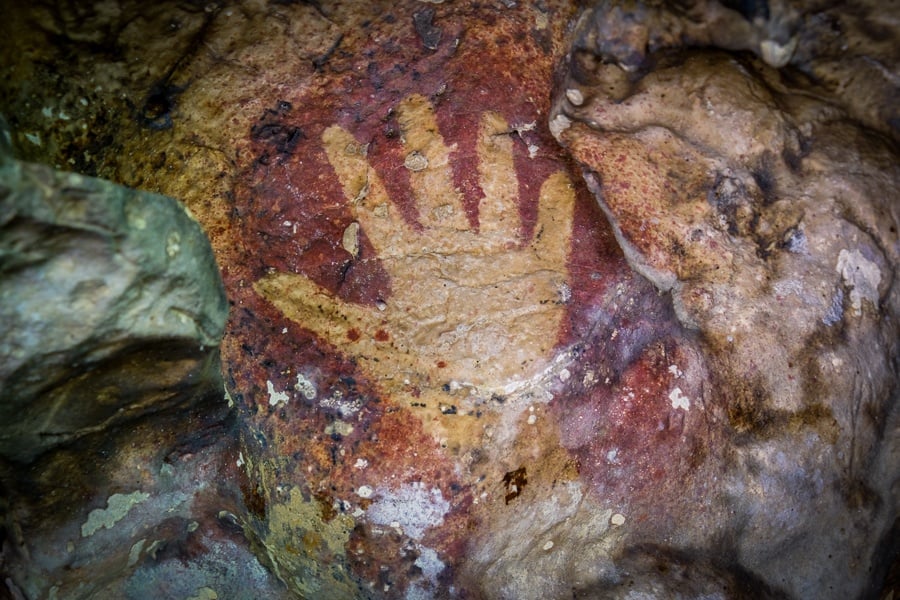
• Stone Forest
This is a group of weird pointy looking rocks mixed in with trees and bushes.
Some of the rocks have tunnels or windows that are fun for pictures.
From a distance it really does look like a stone forest.

Stone forest

Drone pic of the stone forest
More Things To See Nearby
• Leang Leang Karst Caves
There’s another karst geopark in south Sulawesi called Leang Leang, and it’s only a 30 minute drive southeast from Rammang.
This one is known for its prehistoric caves with some of the oldest man made art in the world.
If you have time, definitely add this one to your itinerary too!
Read More: Leang Leang Prehistoric Park
• Tonasa Green Lake
This is a nice pond that’s only a 15 minute drive north of Rammang Rammang (map location here).
It has great reflections of the karsts in the morning, and there’s supposedly another cave here with prehistoric hand prints, although it may require some climbing.
The pond is easy to find, but the road leading to it can be pretty muddy around the rainy season.

Tonasa Green Lake

Reflections
• Leang Surukang Cave
This is a fantastic cave that’s only a 45 minute drive north of Rammang (GPS here).
The cave has several ‘windows’ where you can relax and look out over the rice terraces. It’s a million dollar view, and you have to wonder if cavemen liked to sit in the same spot and admire the view many ages ago.
Leang Surukang is still unknown to tourism and you’ll need a guide to find it. It’s only a 15 minute walk from the parking area, but the path goes through an unmarked (and very confusing) maze of rice fields so it would be hard to find without a guide.
The locals working the rice fields here are friendly, and the surroundings are really nice. Thanks to our driver mentioned earlier (Dodo), we found a guide from the local tourism office and he took us to the cave for 100k Rupiah (~$7).
You walk through the rice paddies, cross a broken bridge over a small stream, and then climb two stairways to the cave. The stairs seemed secure enough, but I don’t think I’d recommend it for elderly folks.

Leang Surukang Cave

Rice farmer

Cave view

The main window

2nd ladder

Cave inside
• Pangkep Museum
This is a nice new museum in Pangkep, about 30 minutes’ drive north from Rammang (GPS here).
It has a bunch of exhibits explaining the archaeology and history behind the karsts in Pangkep and Maros, so if you enjoyed seeing the karsts then this is a good place to come and learn more about them afterwards.
The museum was actually just finished in 2020, and wasn’t technically open to visitors yet because of the covid pandemic. They told us I was the first foreign visitor, so that was fun to know.

Fossils of an extinct wild hog (Celebochoerus) at the Pangkep museum

Pangkep museum

Fossil exhibits
Best Time To Visit
The best months to visit Rammang Rammang and Maros are in the dry season, especially from April to August when things are greenest.
You can definitely visit outside of these months, but it may be more dried out (at the end of the dry season) or rainy (in the middle of the wet season).
The best time of day to visit is early in the morning, before the wind picks up. This is good for photos because you’ll be able to capture the reflections in the ponds at Berua village.
It’s also much less hot in the morning compared to midday. The sun here can be scorching, with temperatures over 30° Celcius, and it’s very humid with very little shade.


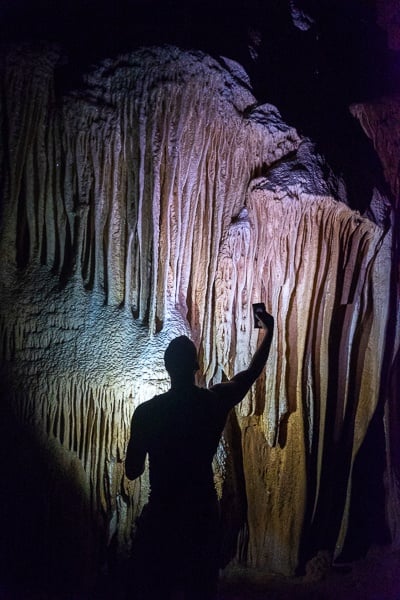

Conservation Status
There’s still a need for better conservation at Rammang Rammang. Indonesia recently got UNESCO Geopark status for this area, but I’d be happy to just see the place cleaned up and kept looking natural.
These are priceless landscapes, but they’re being threatened by development and mining. Sadly we noticed some trash thrown by the locals in the village too, although some of the locals have recently installed garbage bins throughout the area, so hopefully that will help.
If you visit, please keep the place clean. Please pack out your garbage and don’t leave anything at the village. Even if you put it in a trash can, who knows where it’ll end up?



See Also
- Most Beautiful Indonesian Islands – Best Places To Visit In Indonesia
- Best Hikes In Indonesia – Volcanoes, Jungles, & Waterfalls
- Indonesia Waterfall Guide – Best Waterfalls In Indonesia
- Indonesia Beach Guide – Best Beaches In Indonesia
- Best Things To Do In Indonesia – What To Do In The Islands
- Indonesia Travel Guide – Tips, Info, & Photos






